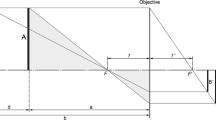Summary
Mirror image production is an extremely, useful tool for the craniofacial surgeon to visualize, in detail, asymmetry or defects, using data and display from three-dimensional CT scanning. The technique for obtaining the mirror image, its limitations, advantages and disadvantages are discussed and clinical cases are presented to demonstrate the usefulness and validity of mirror image production.
Similar content being viewed by others
References
Cutting C, Bookstien FL, Grayson B, Fellingham L, McCarthy JG (1986) Three-dimensional computer assisted design of craniofacial surgery procedures: optimization and interaction with cephalometrics and CT based models. Plast Reconstr Surg 77:877
Donlon WC, Young P, Vassiliadis A (1988) Three-dimensional computed tomography for maxillofacial surgery: report of case. J Oral Maxillofac Surg 46:142
French DJ, Jackson IT, Tolman DE (1988) A system of osseointegrated implants and its application to dental and facial rehabilitation. Eur J Plast Surg 11:14
Heffernan PB, Robb RA (1985) A new method for shaded surface display of biological and medical images. IEEE Transaction on Medical Imaging, MI-4:26
Hoffman EA, McEwan CN (1987) Biomedical applicability of multidimensional image analysis. Proceedings of the AAPM Imaging Course, Ann Arbor, Michigan
Jackson IT, Bite U (1986) Three-dimensional computed tomographic scanning and major surgery reconstruction of the head and neck. Mayo Clin Proc 61:546
Kaplan EN (1987) 3-D CT images for facial implant design and manufacture. Clin Plast Surg 14:663
Marsh JL, Vannier MW, Bresnia S, Hemmer KM (1986) Applications of computer graphics in craniofacial surgery. Clin Plast Surg 13:441
Marsh JL, Vannier MW, Stevens WG, Warren JO, Gayou D, Dye DM (1985) Computerized imaging for soft tissue and osseous reconstruction in the head and neck. Clin Plast Surg 12:279
McEwan CN, Fukuta K (1989) Recent advances in medical imaging. World J Surg 13:343
Robb RA, Barillot C (1988) Interactive display and analysis of 3-D medical images. In: Casasent DP, Tescher AG (eds) Proceedings of the SPIE, Hybrid Image and Signal Processing, 939, 173
Robb RA, Stacy MC, McEwan CN (1987) A networked approach to multi-dimensional biomedical image analysis. Proceedings of the Tenth International Conference on Information Processing in Medical Imaging, held June 22–26 in Utrecht, The Netherlands
Schellhas KP, El Deeb M, Wilkes CH, Check RK, Larsen JW, Heithoff KB, Fritts HM (1988) Three-dimensional computer tomography in maxillofacial surgery planning. Arch Otolaryngol Head Neck Surg 114:438
Toth BA, Ellis DS, Stewart WB (1988) Computer designed prosthesis for orbitocranial reconstruction. Plast Reconstr Surg 81:315
Vannier MW, Marsh JI, Warren JO (1984) Three-dimensional CT reconstruction images for craniofacial surgical planning and evaluation. Radiology 150:179
Author information
Authors and Affiliations
Rights and permissions
About this article
Cite this article
Fukuta, K., Jackson, I.T., McEwan, C.N. et al. Three-dimensional imaging in craniofacial surgery: a review of the role of mirror image production. Eur J Plast Surg 13, 209–217 (1990). https://doi.org/10.1007/BF00634571
Issue Date:
DOI: https://doi.org/10.1007/BF00634571




